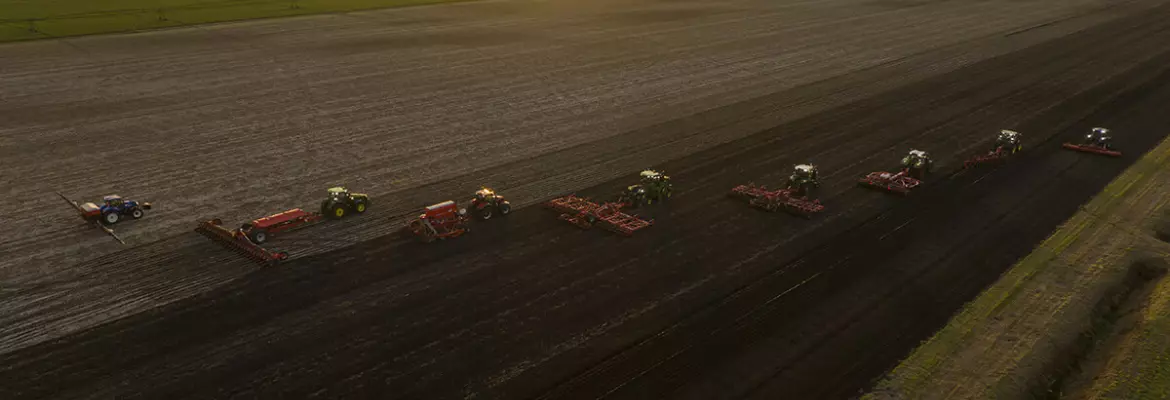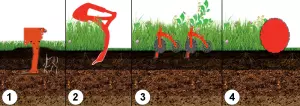
Minimum cultivation techniques include methods ranging from pseudo-ploughing to direct drilling and are mainly used with field and perennial crops. To reap the full benefits in the agrosystem, it is essential to understand their limitations.
Minimum cultivation techniques or ploughing? It all depends on your objectives
While minimum cultivation methods are a step towards conservation farming, the plough is still useful in many situations. It all depends on the soil, the climate, how your farm is organised and, of course, your objectives. The choice of methods is determined by the soil type and the issues encountered. It’s essential to have a comprehensive grasp of the soil before implementing these minimum tillage practices. These processes are part of an agroecological initiative, which aims to lessen the environmental footprint of agriculture, with a particular focus on soil conservation.
The advantage of Min-Till for the structure and life of the soil
The main advantage of Min-Till compared to ploughing is that it doesn’t disturb the structure of the soil as tillage tools do not turn the soil completely. As a result, soil life is better preserved with richer fauna (earthworms for example) and flora. At the surface, at least, plant debris and crop residues etc. constitute a more abundant organic matter. The ultimate Min-Till technique, direct drilling, maintains soil cover on the surface to limit erosion and slaking, and boost water infiltration. Another advantage is the reduction of the greenhouse gas, carbon dioxide, due it being stored in the soil as well as fewer tractor passes.
Minimum cultivation techniques have proven effective for many years now with yields comparable to ploughed land, and time and energy savings appreciated by farmers. Min-Till is used on 35 % of the UAA in France – Source, Agro-league

Ploughing can be useful
For farmers, the benefits of Min-Till should not lead to overlooking the plough, which can still be useful. It helps manage weed-control difficulties, especially with grasses. In organic farming, the plough is widely used because it eliminates the need for herbicides to control weeds. It is more adapted than Min-Till methods to wet conditions: the plough is capable of working wet land which is not the case of a soil loosener, for example, which requires a soil that is easy to crumble. The plough can be useful for restructuring the soil if it is compacted, however, care should be taken not to create a plough pan.

In terms of soil fertility, where ploughing is often criticised, the facts need to be more nuanced, according to Jean-François Vian, lecturer and researcher at ISARA Lyon, France, who points out that it is the ploughing conditions that can have a negative impact, rather than the practice itself. According to this researcher, ploughing at the right time on soil that has settled to a maximum depth of 20cm does not harm soil fertility. According to scientific studies, worked soils have more bacterial species, whereas reducing or eliminating tillage encourages the development of fungi.
Consider timing, crop, soil type and weather conditions in your cultivation programme
Min-Till or ploughing then? The choice depends on many factors that may be related to the particular year but also to soil type and farm organisation.
For instance, the plough is very often used (80%) in a region like Brittany, France, to plant spring crops, followed by a pass with a power harrow before seeding. This process allows the soil to warm up so that crops can be planted quickly. This is also the case in regions with clay soils, such as Lorraine, where winter ploughing exposes the soil to frost before working the soil again in the spring to prepare the seedbed. On the other hand, no-plough methods have made great strides in regions such as the Great Danube Plain, where soils are very light.
In agronomic terms, the organisation of the farm, available equipment, and crop rotation all need to be considered, as well as soil types and farmers' practices. All of these factors mean that ploughing and Min-Till often complement each other.

Find out more about no-plough methods
-
No-plough cultivation techniques (Min-Till) are farming methods that consist in cultivating the land without using a plough or other tools that turn the soil.
-
On average, shallow cultivation involves working to a depth of between 2 and 15cm, whereas deep tillage can go down to depths of 30 to 35cm. Note: working depth depends on the machine that is used.
-
There are several different ways to improve biological activity in the soil, including:
- Using cultivation techniques that enhance microbial life such as cover crops, crop rotation, and no-plough.
- Adding organic matter to the soil in the form of compost, manure, or crop residues.
- Avoiding the excessive use of chemical fertilisers and herbicides that can have a negative impact on microbial life in the soil.
- Maintaining permanent soil cover with plant cover or a suitable crop rotation.
- Preventing soil compaction by reducing the number of passes with agricultural machinery. These practices boost microbial life in the soil which plays an essential role in producing fertile, healthy crops.
-
Inter-crops are intermediate cover crops planted between two main crops to protect the soil, increase fertility, and promote microbial life. They can reduce nitrate leaching by absorbing residual nitrogen in the soil after the main crop has been harvested.
Intercropping cover crops and Min-Till are both methods that limit crop management to a minimum. The limited valorisation of inter-crops means that planting costs are reduced.
A multi-purpose cultivator with vibrating tines is an ideal Min-Till method for preparing the seedbed with a second pass with a stubble cultivator. This is particularly useful for controlling weeds with inter-cropping.
-
Weeds and pests need to be considered and treated accordingly. Care should be taken to avoid weed regrowth. If harvest residues are not buried, they should be finely shredded to reduce disease and pest problems.
-
A stubble cultivator consumes less fuel than a plough and preserves organic matter content in the topsoil. In addition, soil compaction is reduced and there is little disturbance of the soil’s biodiversity.
